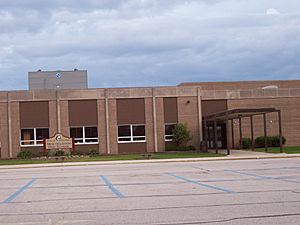New Holstein, Wisconsin facts for kids
Quick facts for kids
New Holstein, Wisconsin
|
|
|---|---|

Main Street in New Holstein
|
|

Location of New Holstein in Calumet County, Wisconsin
|
|
| Country | |
| State | |
| County | Calumet |
| Area | |
| • Total | 2.51 sq mi (6.50 km2) |
| • Land | 2.51 sq mi (6.49 km2) |
| • Water | 0.00 sq mi (0.01 km2) |
| Elevation | 932 ft (284 m) |
| Population
(2020)
|
|
| • Total | 3,098 |
| • Estimate
(2024)
|
2,891 |
| • Density | 1,236.84/sq mi (477.61/km2) |
| Time zone | UTC-6 (Central (CST)) |
| • Summer (DST) | UTC-5 (CDT) |
| Area code(s) | 920 |
| FIPS code | 55-56800 |
| GNIS feature ID | 1570219 |
New Holstein is a friendly city located in Calumet County, in the state of Wisconsin in the United States. As of 2024, about 2,891 people call New Holstein home. It's nestled within the larger Town of New Holstein.
Contents
History of New Holstein
New Holstein gets its name from Holstein, a region in Germany. Many of the first people to settle here came from that area.
Early Settlers and Naming the Town
In 1848, about 70 people from Hamburg, Germany, traveled to this area. They were looking for a new home because they worried about a possible war in their homeland. These settlers started the community that grew into New Holstein.
They first called their new home Altona, after a place in Hamburg. However, the United States Post Office asked them to change the name. This was because Altona sounded too much like Altoona, Wisconsin, another town in western Wisconsin.
In the early days, settlers had to travel to Calumetville, Wisconsin to get supplies. They also found plenty of wild game, like passenger pigeons, for food.
Founding and Growth
The very first settlers in the city were Charles Greening and two friends. Dr. Charles Bock arrived soon after. The first postmaster (the person in charge of the mail) was Monsignor Puchner, a Roman Catholic priest.
In 1849, the town was officially organized. Charles Greening became the first chairman and later a county judge in 1855. More settlers continued to arrive from Germany throughout the mid-1800s. People even formed a drama group in 1851 to put on plays.
Arrival of the Railroad
Plans for a railroad were made in 1871. A train station was built, and the railroad arrived in 1872. The railroad company decided to name the station "New Holstein" after the town.
After the railroad came, mail arrived by train instead of by Pony Express. The first post office was built shortly after the train service began.
New Holstein in the Late 1800s and Early 1900s
By 1881, New Holstein had about 400 residents. Almost everyone was either from Germany or had German family. The village covered more than one square mile. It had two public halls, three hotels, a fire insurance company, and a cemetery.
The main business in New Holstein was a flour mill. Near the railroad depot, there was a grain elevator owned by Herman Timm.
In 1900, the population grew to 569 people. New Holstein officially became a village the next year. The first electric lights were installed in the city in 1912.
Becoming a City
New Holstein became a city in April 1926. The first city council included Mayor Edward Funke and other important leaders.
Today, the mayor of New Holstein is Richard Snelson. The chief of police is Eric Fisher, and the fire chief is Denis Mayer.
Geography of New Holstein
New Holstein is located in Wisconsin. It covers an area of about 2.50 square miles (6.50 square kilometers). All of this area is land.
Population of New Holstein
New Holstein has grown over the years. Here's how the population has changed:
| Historical population | |||
|---|---|---|---|
| Census | Pop. | %± | |
| 1890 | 426 | — | |
| 1910 | 839 | — | |
| 1920 | 1,373 | 63.6% | |
| 1930 | 1,274 | −7.2% | |
| 1940 | 1,502 | 17.9% | |
| 1950 | 1,831 | 21.9% | |
| 1960 | 2,401 | 31.1% | |
| 1970 | 3,012 | 25.4% | |
| 1980 | 3,412 | 13.3% | |
| 1990 | 3,342 | −2.1% | |
| 2000 | 3,301 | −1.2% | |
| 2010 | 3,236 | −2.0% | |
| 2020 | 3,098 | −4.3% | |
| 2024 (est.) | 2,891 | −10.7% | |
| U.S. Decennial Census | |||
Population in 2010
In 2010, there were 3,236 people living in New Holstein. There were 1,394 households, which are groups of people living together.
Most of the people living in New Holstein were White (96.4%). A small number of people were from other racial backgrounds. About 3.2% of the population identified as Hispanic or Latino.
The average age of people in New Holstein was 44.7 years old. About 20.5% of residents were under 18 years old.
Transportation in New Holstein
The New Holstein Municipal Airport (8D1) helps people travel to and from the city. It also serves the nearby communities.
Education in New Holstein
Students in New Holstein attend schools run by the School District of New Holstein. This district includes:
- New Holstein High School
- New Holstein Middle School
- New Holstein Elementary School
Notable People from New Holstein
Many interesting people have come from New Holstein:
- W. W. Albers, a state senator in Wisconsin
- Ken Criter, a former professional football player for the Denver Broncos
- Dan Feyen, a state senator in Wisconsin
- Richard J. Greuel, a legislator in Alaska
- Otto Hackbarth, a professional golfer
- Hildegarde, a famous singer
- George H. Hipke, a state senator in Wisconsin
- Gilbert Hipke, a state representative in Wisconsin
- Alfred A. Laun Jr., a state senator in Wisconsin
- Otto Luehrs, a state representative in Wisconsin
- Adolph Moeller, a state representative in Wisconsin
- Gustave Moeller, a painter
- Edward Schildhauer, a chief engineer for the Panama Canal project
- Bob Schmitz, a former professional football player for the Pittsburgh Steelers and Minnesota Vikings
- Harry Steenbock, a biologist
- Wilfrid J. Turba, a state representative in Wisconsin
Landmarks in New Holstein
See also
 In Spanish: New Holstein (Wisconsin) para niños
In Spanish: New Holstein (Wisconsin) para niños



